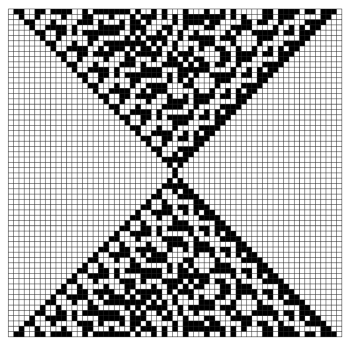ComputationalFoundations: Difference between revisions
added computational boundedness |
No edit summary |
||
| Line 2: | Line 2: | ||
== Overview == | == Overview == | ||
[[File:reverse.png|350px|thumb|right|A reversible cellular automata.]] | |||
'''[[Computational Foundations]]''' refers to a scientific framework that views computation as a fundamental principle underlying natural and artificial systems. This paradigm builds upon concepts introduced in [[Stephen Wolfram]]'s "A New Kind of Science" and similar computational approaches to understanding complex phenomena. Unlike traditional mathematical frameworks, Computational Foundations suggests that many [[physical]], [[biological]], and [[social systems]] can be best understood as computational processes governed by simple rules that generate complex behaviors. | '''[[Computational Foundations]]''' refers to a scientific framework that views computation as a fundamental principle underlying natural and artificial systems. This paradigm builds upon concepts introduced in [[Stephen Wolfram]]'s "A New Kind of Science" and similar computational approaches to understanding complex phenomena. Unlike traditional mathematical frameworks, Computational Foundations suggests that many [[physical]], [[biological]], and [[social systems]] can be best understood as computational processes governed by simple rules that generate complex behaviors. | ||
Latest revision as of 02:28, 21 April 2025
Computational Foundations
Overview

Computational Foundations refers to a scientific framework that views computation as a fundamental principle underlying natural and artificial systems. This paradigm builds upon concepts introduced in Stephen Wolfram's "A New Kind of Science" and similar computational approaches to understanding complex phenomena. Unlike traditional mathematical frameworks, Computational Foundations suggests that many physical, biological, and social systems can be best understood as computational processes governed by simple rules that generate complex behaviors.
The framework has expanded significantly with Wolfram's Physics Project, which proposes that the universe itself is fundamentally computational at its core, operating through simple rules applied to hypergraphs that can generate space, time, and fundamental physics [1].
Core Principles
Computational Universality
The principle that relatively simple computational systems can achieve the same computational capabilities as any other computational system, including those found in nature.
Computational Irreducibility
Many computational processes cannot be significantly simplified or predicted without actually running them through each step. This challenges traditional reductionist approaches to science. The Wolfram Physics Project extends this concept to fundamental physics, suggesting that many properties of our universe cannot be derived through mathematical shortcuts but must be computationally evolved through their complete history [2].
Computational Boundedness
Bounded computation refers to the limitations on the amount of computation a system or an observer can perform within a given timeframe. This point is emphasized in the Wolfram Physics Project, in that observers like us are computationally bounded in our capabilities, which means we are not able to “see through the computational irreducibility", resulting in the out of bounds behavior that “looks random to us”.
Emergent Complexity
Simple computational rules can generate highly complex patterns and behaviors that are not evident from the underlying rules alone.
Discrete Foundations
Physical reality might be fundamentally discrete rather than continuous, making computational models particularly suitable for describing natural phenomena. The Wolfram Physics Project specifically proposes a discrete model of spacetime based on evolving networks or hypergraphs, challenging continuous mathematical descriptions of physics [3].
Theoretical Framework
Computational Foundations integrates several key theoretical approaches:
- Cellular Automata: Simple grid-based systems with local rules that can generate complex global patterns
- Network Science: The study of complex networks and their emergent properties
- Algorithmic Information Theory: Measuring complexity through computational descriptions
- Computational Complexity Theory: Classifying problems by their inherent difficulty
- Metamathematical Physicalization: Treating mathematics itself as a physical, computational system rather than an abstract platonic realm [4].
Applications Across Fields
Physics
- Digital Physics: Theories suggesting the universe operates like a computational system
- Quantum Computation: Understanding quantum systems through computational models
- Complex Systems: Modeling physical systems that exhibit emergent properties
- Wolfram Physics Project: A comprehensive framework attempting to derive fundamental physics from simple computational rules operating on hypergraphs, potentially explaining quantum mechanics, relativity, and their unification through computational principles [5].
Biology
- Computational Biology: Modeling biological systems as information-processing networks
- Artificial Life: Creating computational models that exhibit life-like behaviors
- Morphogenesis: Explaining biological pattern formation through computational rules
- Biological Evolution as Computation: Recent computational models explaining how biological evolution works through adaptive cellular automaton models, demonstrating how computational processes enable effective biological adaptation [6].
- Medical Formalization: New computational frameworks for the foundations of medicine that treat biological systems as fundamentally computational phenomena, connecting theoretical biology with practical medical applications [7].
Social Sciences
- Computational Sociology: Modeling social dynamics and collective behaviors
- Agent-Based Modeling: Simulating emergent social phenomena from individual interactions
- Network Analysis: Understanding social connections and information flow
Computer Science
- Algorithmic Design: Developing new approaches inspired by natural computation
- Machine Learning: Creating systems that learn from data using computational principles
- Artificial Intelligence: Developing computational models of intelligence
References
- ↑ Stephen Wolfram, "Finally We May Have a Path to the Fundamental Theory of Physics—and It’s Beautiful", [1]
- ↑ Stephen Wolfram, "The Wolfram Physics Project: A One-Year Update", [2]
- ↑ Stephen Wolfram, "How We Got Here: The Backstory of the Wolfram Physics Project", [3]
- ↑ Stephen Wolfram, "The Physicalization of Metamathematics and Its Implications for the Foundations of Mathematics", [4]
- ↑ Stephen Wolfram, "Finally We May Have a Path to the Fundamental Theory of Physics—and It’s Beautiful", [5]
- ↑ Stephen Wolfram, "Why Does Biological Evolution Work? A Minimal Model for Biological Evolution and Other Adaptive Processes", [6]
- ↑ Stephen Wolfram, "Towards a Computational Formalization for Foundations of Medicine", [7]